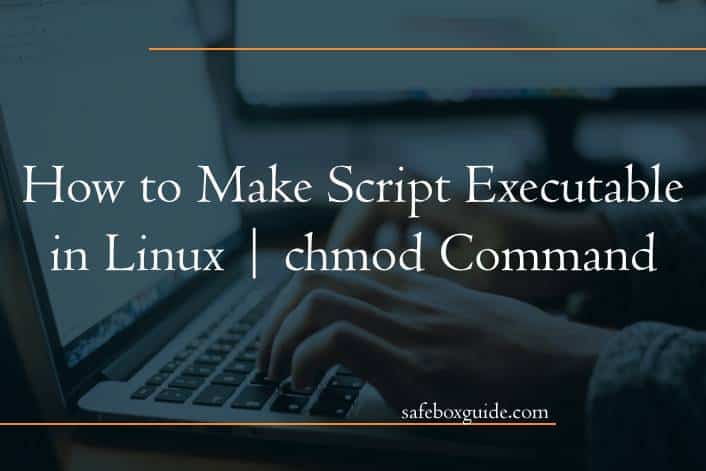Have you ever downloaded a script in Linux, only to find yourself scratching your head when trying to run it? Fear not, for the solution lies within the powerful chmod command. Making a script executable in Linux may seem like a daunting task for beginners, but with a little guidance and understanding of file permissions, you’ll be running your scripts with ease in no time. In this article, we will delve into the world of chmod and explore how it can be used to make scripts executable on your Linux system. So grab your terminal and get ready to unleash the full potential of your scripts!
Contents
Understanding file permissions in Linux
Understanding file permissions in Linux is crucial for ensuring the security and functionality of your system. File permissions in Linux consist of three sets – read, write, and execute – for the owner, group, and others. The `chmod` command is used to change these permissions based on who should be able to perform various actions on the file. By setting appropriate permissions, you can control who can view, edit, or execute a particular file.
One important aspect of file permissions in Linux is understanding symbolic notation versus octal notation. While octal notation involves using numbers like 4, 2, or 1 to represent read, write, and execute respectively for each category (owner-user-group-others), symbolic notation uses letters like rwx followed by symbols such as + or – to add or remove permissions. Knowing how to navigate both systems allows for flexibility in managing file permissions effectively.
In conclusion, mastering file permissions in Linux through the `chmod` command provides a valuable skillset for any user working within a Unix-based environment. By grasping the intricacies of permission settings and understanding both symbolic and octal notations, users can enhance security measures while enabling smooth collaboration on shared files among different user categories. Remember that proper permission management not only safeguards your data but also optimizes system performance by allowing only relevant access levels where needed.

Making a script executable using chmod
Making a script executable in Linux using the `chmod` command is a fundamental skill that empowers users to run scripts with ease. By assigning the execute permission to a script, you are granting yourself and other users the ability to directly run it. This can streamline processes and enhance workflow efficiency by eliminating the need to repeatedly type out commands.
One key advantage of using the `chmod` command is its flexibility in specifying permissions for different user groups. With just a single line of code, you can determine whether only the file owner, specific group members, or all users have permission to execute the script. This level of control enables you to tailor access rights according to security requirements or operational needs, making your script management more secure and efficient.
By mastering how to make a script executable using the `chmod` command, you not only gain practical skills but also develop a deeper understanding of Linux system administration. Empowering yourself with this knowledge opens up new possibilities for scripting automation and enhances your overall proficiency in navigating the Linux environment effectively.
Examples of chmod command usage
In addition to setting executable permissions on scripts, the chmod command in Linux offers a range of usage examples for managing file permissions. One common scenario is changing the ownership of a file using the chown command alongside chmod. By combining these two commands, users can easily modify both ownership and permissions on files simultaneously.
Another interesting use case of the chmod command is utilizing symbolic notation to adjust file permissions. This method allows users to specify permission changes in a more readable and intuitive manner compared to numerical notation. For instance, using symbolic notation like u+rwx can grant the user read, write, and execute permissions without having to calculate numeric values.
Moreover, leveraging special permissions with the chmod command enables advanced control over access rights. The setuid (suid), setgid (sgid), and sticky bit are examples of special permissions that can be applied using chmod to enable specific functionality or security measures within files or directories. Understanding these advanced options can enhance overall security practices in Linux systems while also providing tailored access controls for different user groups.

Common errors and troubleshooting tips
In the world of Linux script execution, errors can be common stumbling blocks that disrupt smooth operations. One frequent error users encounter is forgetting to include the ./ before the script name when trying to execute a script located in the current directory. This simple oversight can lead to frustrating command not found messages. To troubleshoot this issue, simply ensure that you prepend ./ before the script’s filename.
Another common error is related to file permissions, where users might face Permission Denied errors while attempting to run a script. This occurs when the user lacks sufficient permissions on the file to execute it. A quick troubleshooting tip for this problem involves using the chmod command with appropriate permission settings to grant executable rights on the script file for your user account. By doing so, you empower yourself to seamlessly execute scripts without encountering pesky permission issues.
Best practices for script execution
When it comes to executing scripts in Linux, following best practices is essential to ensure smooth and efficient operation. Firstly, always start by checking the script for any syntax errors or bugs before attempting to run it. This proactive approach can save you a lot of time and frustration down the line. Additionally, consider implementing proper error handling within your scripts to capture any unexpected issues that may arise during execution.
Furthermore, it’s recommended to specify the interpreter for the script using a shebang line at the beginning of your script (e.g., #!/bin/bash). This step helps ensure that the script is executed with the correct interpreter, avoiding compatibility issues. When granting executable permissions using chmod command, be mindful of security concerns and only provide necessary privileges to prevent unauthorized access or modifications. By adhering to these best practices, you can streamline your scripting process and create more reliable and secure executable files in Linux systems.

Conclusion: Mastering script execution in Linux
Mastering script execution in Linux is a crucial skill for any system administrator or developer. Understanding how to use the chmod command effectively can significantly streamline your workflow and help you execute scripts with ease. By setting the appropriate permissions, you can ensure that your scripts are only executed by authorized users, enhancing security and preventing unauthorized access.
Moreover, delving deeper into the intricacies of script execution in Linux allows you to automate repetitive tasks, thereby saving time and increasing productivity. Utilizing the full power of the chmod command enables you to fine-tune permissions based on specific requirements, granting flexibility and control over script execution. With practice and experimentation, you can unlock the full potential of scripting in Linux and elevate your efficiency to new heights.

